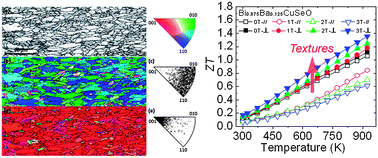Thermoelectric power generation technology aims to harvest and convert waste heat into electricity. Researchers are looking for not toxic, abundant and inexpensive new materials with good thermal and chemical stability in air at high temperatures.
Quaternary oxyselenides (BiCuSeO) have been addressed as a promising thermoelectric system to use in sustainable energy generation from waste heat. Thermoelectric conversion efficiencies for these materials is described by the dimensionless figure of merit, ZT, which has reached a maximum value of about 1.4. Textured Bi0.875Ba0.125CuSeO has outperformed this value due to its low thermal conductivity and improved electrical transport properties, which has been achieved by increasing carrier concentration through optimising dopants.
In a recent article by Li-Dong Zhao and co-workers, a hot-forging process was used to produce grains oriented along a preferential axis. A higher carrier mobility along the direction perpendicular to the pressing direction was also obtained. The microstructure was then observed using X-ray diffraction (XRD) and scanning electron microscopy (SEM).
The highest ZT value ever reported for oxygen containing materials was achieved making oxyselenides a valid candidate for medium temperature thermoelectric applications.
Interested in a better understanding about this field? Read more from the Communication article:
Texturation boosts the thermoelectric performance of BiCuSeO oxyselenides
Jiehe Sui, Jing Li, Jiaqing He, Yan-Ling Pei, David Berardan, Haijun Wu, Nita Dragoe, Wei Cai and Li-Dong Zhao
DOI: 10.1039/C3EE41859F, Communication
By Martina Congiu











